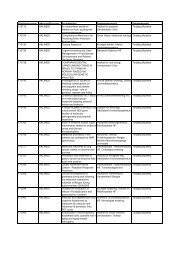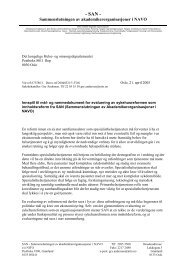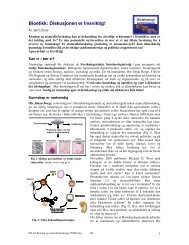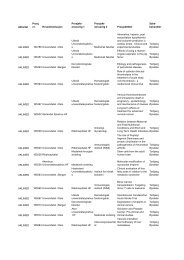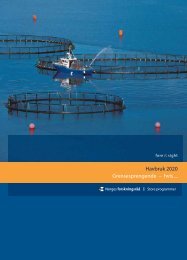A Revolution in R&D
A Revolution in R&D
A Revolution in R&D
Create successful ePaper yourself
Turn your PDF publications into a flip-book with our unique Google optimized e-Paper software.
PHARMACOGENETICS—FOUR APPLICATIONS<br />
To evaluate pharmacogenetics properly, companies<br />
need to take an especially close look at the market<br />
dynamics. These dynamics vary accord<strong>in</strong>g to how<br />
pharmacogenetics is used. We have identified four<br />
such applications (each associated with a different<br />
category of patient respond<strong>in</strong>g to a given drug). The<br />
first three are used to exclude patients from trials;<br />
the fourth is used to expand the potential market for<br />
the drug.<br />
First, efficacy prediction identifies patients who will<br />
show no real or significant response to the drug—<br />
perhaps because they metabolize the drug <strong>in</strong> an<br />
unusual way, or have an unusual form or comb<strong>in</strong>ation<br />
of susceptibility genes. A typical drug produces<br />
this negligible response <strong>in</strong> about a third of patients,<br />
but sometimes the proportion is far higher. For<br />
example, Cognex (tacr<strong>in</strong>e), the first drug for<br />
Alzheimer’s, is <strong>in</strong>efficacious <strong>in</strong> more than 50 percent<br />
of patients. The vary<strong>in</strong>g response is associated with<br />
differ<strong>in</strong>g versions of the ApoE gene, and is therefore<br />
readily predictable by a pharmacogenetic test.<br />
Second, common-side-effect prediction identifies<br />
patients likely to experience familiar side effects, as<br />
a result of metabolic difficulties caused by wellknown<br />
enzymes. A test can screen out negative<br />
responders—“slow acetylators,” for <strong>in</strong>stance. The<br />
acetylation polymorphism <strong>in</strong> the NAT2 gene is one of<br />
the commonest genetic variations <strong>in</strong> drug metabolism;<br />
it has the effect of reduc<strong>in</strong>g the enzyme’s lifespan<br />
and thus reduc<strong>in</strong>g the effective amount of the<br />
enzyme <strong>in</strong> cells at any one time. This polymorphism<br />
is present <strong>in</strong> more than 50 percent of Caucasians,<br />
who are thus at greater risk of drug toxicity.<br />
Knowledge of this polymorphism could save a drug<br />
<strong>in</strong> cl<strong>in</strong>ical trials that would otherwise be abandoned.<br />
Third, very-rare-side-effect prediction identifies patients<br />
at risk for unconventional side effects, but<br />
comes <strong>in</strong>to play only after the drug is on the market.<br />
Unlike most of the common side effects, which are<br />
associated with metabolic pathways and usually<br />
emerge <strong>in</strong> precl<strong>in</strong>ical studies, these rare side effects<br />
tend to be provoked by nonmetabolic genes, and to<br />
be overlooked at first. They cannot easily be predicted,<br />
s<strong>in</strong>ce there are too many possible sources<br />
(modifications of the target or of the disease pathway,<br />
or unrelated pathways), and they may occur too<br />
rarely to show up <strong>in</strong> cl<strong>in</strong>ical trials.<br />
A case <strong>in</strong> po<strong>in</strong>t is Lotronex, a drug for irritable bowel<br />
syndrome, now withdrawn from the market. Only<br />
after its market launch, and 450,000 prescriptions,<br />
did its severe side effect (bowel impaction) become<br />
apparent. About one <strong>in</strong> 6,500 patients was<br />
affected—a frequency far too rare for a standard<br />
cl<strong>in</strong>ical trial to detect beforehand. (A typical trial<br />
<strong>in</strong>volves about 5,000 patients: for this side effect to<br />
have been manifest <strong>in</strong> a statistically significant way,<br />
a trial of nearly 100,000 patients would have been<br />
needed.) Pharmacogenetics could <strong>in</strong> certa<strong>in</strong> cases<br />
come to the rescue of such compromised drugs, by<br />
belatedly devis<strong>in</strong>g a screen<strong>in</strong>g test.<br />
F<strong>in</strong>ally, market expansion identifies patients who are<br />
currently unsuited to the drug but potentially responsive<br />
to it. S<strong>in</strong>ce f<strong>in</strong>e-tun<strong>in</strong>g of dosages or formulation<br />
can often reduce side effects and occasionally<br />
improve efficacy, pharmacogenetics could reassess<br />
and upgrade many of the supposedly <strong>in</strong>eligible<br />
patients. The market for the drug might expand considerably<br />
as a result.<br />
Take the case of cyclophosphamide, a chemotherapy<br />
drug, which works only when metabolized by the<br />
enzymes CYP3A4 and CYP3A5. Some patients<br />
appear underresponsive to it: a genetic variation<br />
suppresses the activity of the enzymes, thereby<br />
decreas<strong>in</strong>g the amount of active drug <strong>in</strong> the bloodstream.<br />
The best course is not to discont<strong>in</strong>ue the<br />
drug, but to compensate by tak<strong>in</strong>g a higher dosage.<br />
A pharmacogenetic test could identify the appropriate<br />
patients prior to treatment, and their consumption<br />
of the drug, <strong>in</strong>stead of decl<strong>in</strong><strong>in</strong>g to zero, would<br />
actually <strong>in</strong>crease.<br />
37



